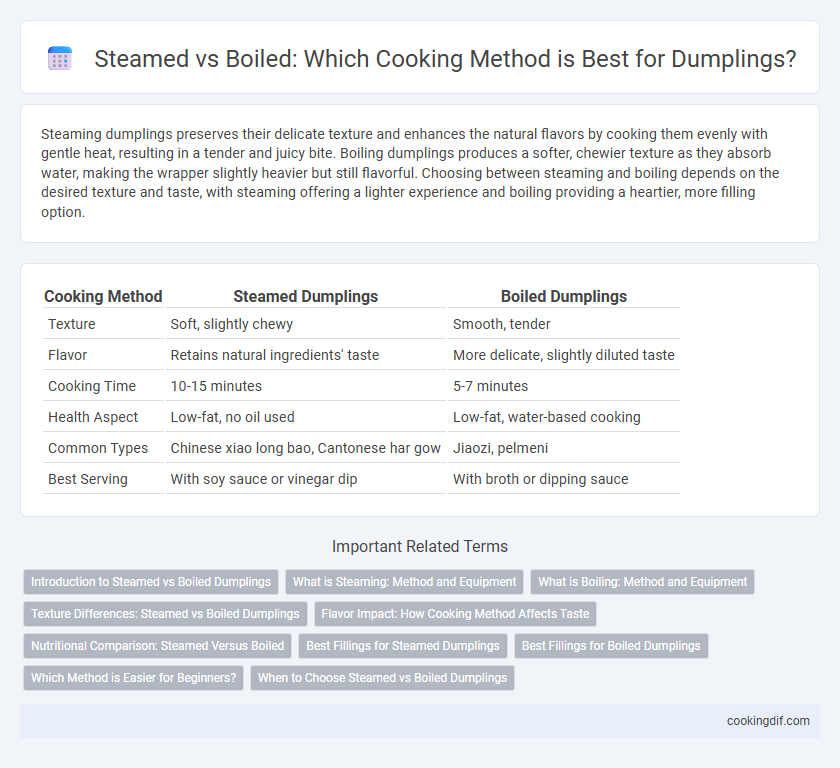Steaming dumplings preserves their delicate texture and enhances the natural flavors by cooking them evenly with gentle heat, resulting in a tender and juicy bite. Boiling dumplings produces a softer, chewier texture as they absorb water, making the wrapper slightly heavier but still flavorful. Choosing between steaming and boiling depends on the desired texture and taste, with steaming offering a lighter experience and boiling providing a heartier, more filling option.
Table of Comparison
| Cooking Method | Steamed Dumplings | Boiled Dumplings |
|---|---|---|
| Texture | Soft, slightly chewy | Smooth, tender |
| Flavor | Retains natural ingredients' taste | More delicate, slightly diluted taste |
| Cooking Time | 10-15 minutes | 5-7 minutes |
| Health Aspect | Low-fat, no oil used | Low-fat, water-based cooking |
| Common Types | Chinese xiao long bao, Cantonese har gow | Jiaozi, pelmeni |
| Best Serving | With soy sauce or vinegar dip | With broth or dipping sauce |
Introduction to Steamed vs Boiled Dumplings
Steamed dumplings retain a tender, moist texture with a delicate chewiness, as the gentle steam preserves the filling's juiciness and nutrients. Boiled dumplings achieve a softer, slightly elastic texture from direct contact with boiling water, resulting in a more cohesive dough exterior. Choosing between steamed and boiled dumplings depends on desired texture and flavor intensity, with steaming highlighting subtle fillings and boiling offering heartier, more uniform cooking.
What is Steaming: Method and Equipment
Steaming dumplings involves cooking them with moist heat by placing them in a bamboo or metal steamer basket above boiling water, allowing steam to circulate and cook evenly. This method preserves the dumplings' texture and moisture, resulting in a soft, tender exterior while keeping the filling juicy. Common equipment for steaming includes bamboo steamers, metal racks, and electric steamers, which provide precise temperature control and consistent steam flow for optimal results.
What is Boiling: Method and Equipment
Boiling dumplings involves cooking them in rapidly boiling water, typically using a pot or deep pan large enough to allow free movement and even cooking. The method ensures dumplings are fully submerged, requiring periodic stirring to prevent sticking and maintain consistent temperature. Common equipment includes a heavy-bottomed saucepan and a slotted spoon for easy removal once the dumplings float.
Texture Differences: Steamed vs Boiled Dumplings
Steamed dumplings have a tender, slightly chewy texture with a smooth, moist surface, preserving the filling's juiciness. Boiled dumplings often feature a softer, more delicate dough that can be slightly slippery, absorbing flavors from the cooking liquid. The choice between steaming and boiling impacts the dumpling wrapper's firmness and overall mouthfeel, influencing the eating experience.
Flavor Impact: How Cooking Method Affects Taste
Steaming dumplings preserves their delicate fillings and results in a tender, juicy texture with enhanced natural flavors, maintaining moisture without dilution. Boiling dumplings infuses them with a subtle soup-like essence, slightly softening the wrapper and blending the filling's taste with the cooking water. Each method uniquely influences the flavor profile by controlling moisture retention and heat exposure, shaping the overall tasting experience.
Nutritional Comparison: Steamed Versus Boiled
Steamed dumplings retain more nutrients such as vitamins B and C, as the gentle cooking method preserves water-soluble compounds better than boiling. Boiled dumplings, immersed in water, can lose some minerals and antioxidants due to leaching into the cooking water. Overall, steaming offers a healthier cooking option by maintaining higher nutrient levels and reducing nutrient loss.
Best Fillings for Steamed Dumplings
Steamed dumplings best complement fillings with moist, tender ingredients such as ground pork mixed with Napa cabbage, shrimp combined with garlic chives, or chicken paired with shiitake mushrooms, as the gentle steaming method preserves their delicate flavors and juicy textures. The steam cooking process retains moisture within the dumpling, enhancing the succulence of vegetables and proteins that release natural juices, ensuring an evenly cooked and flavorful bite. Choosing fillings rich in umami and moisture balances well with the soft, slightly chewy steamed dough, creating an optimal taste and texture experience.
Best Fillings for Boiled Dumplings
Boiled dumplings best complement moist, tender fillings such as pork mixed with napa cabbage or shrimp with minced garlic and ginger, as the boiling process retains juiciness and enhances natural flavors. Vegetables like chives, mushrooms, and tofu work well in boiled dumplings since the gentle cooking preserves their texture without drying out. The boiling method suits high-moisture fillings that release flavorful broth, creating a rich tasting experience inside each dumpling.
Which Method is Easier for Beginners?
Steaming dumplings is generally easier for beginners because it requires less attention to prevent sticking or tearing compared to boiling. The steaming process preserves the dumplings' shape and prevents them from breaking apart in water, making it more forgiving for novices. Additionally, using a bamboo or metal steamer basket simplifies handling and ensures even cooking, ideal for first-time dumpling makers.
When to Choose Steamed vs Boiled Dumplings
Steamed dumplings are ideal when preserving the delicate texture and flavor of the filling is a priority, as steaming retains moisture without diluting taste. Boiled dumplings are best suited for heartier fillings or when a softer, more tender wrapper is desired, benefiting from direct water immersion to achieve a chewy texture. Choose steamed dumplings for a light, fluffy bite and boiled dumplings for a rich, soup-ready option.
Steamed vs Boiled for Cooking Method Infographic

 cookingdif.com
cookingdif.com